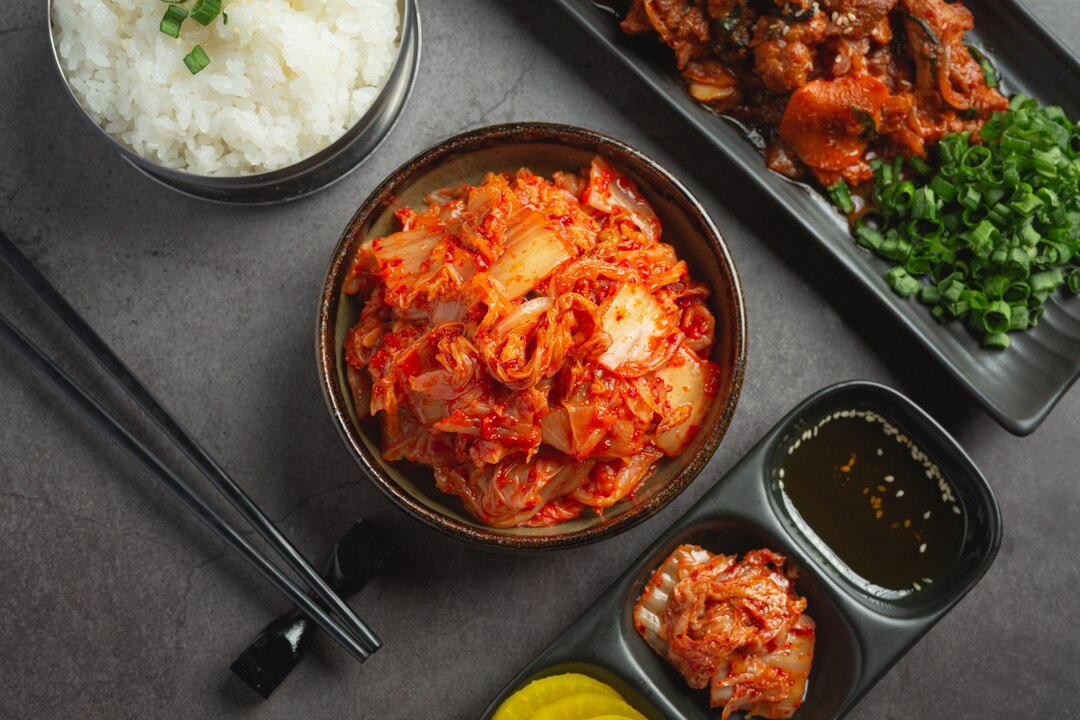Kimchi, a staple of Korean cuisine, is not just a side dish—it’s a cultural icon bursting with flavor and health benefits. Made from fermented vegetables, typically napa cabbage and Korean radishes, kimchi offers a harmonious blend of spicy, salty, and tangy flavors that tantalize the taste buds. Let’s explore how to make this beloved Korean dish right in your own kitchen:
Ingredients:
- 1 napa cabbage (about 2 pounds)
- 1/4 cup of coarse sea salt
- 4 cups of water (for brining)
- 1 daikon radish, julienned
- 4 green onions, chopped
- 4 cloves of garlic, minced
- 1 tablespoon of ginger, grated
- 3 tablespoons of Korean red pepper flakes (gochugaru)
- 2 tablespoons of fish sauce (optional for a traditional flavor)
- 1 tablespoon of sugar
- 1 tablespoon of salted shrimp paste (saeujeot) (optional, for additional umami)
Instructions:
- Prepare the Cabbage: Cut the napa cabbage lengthwise into quarters and remove the core. Then, chop the cabbage into bite-sized pieces. Place the chopped cabbage in a large bowl and sprinkle with coarse sea salt. Toss gently to coat each piece. Let it sit for 1-2 hours to allow the salt to draw out excess moisture.
- Brine the Cabbage: In a separate bowl, dissolve the remaining salt in water to create a brine solution. After the cabbage has wilted, rinse it thoroughly under cold water to remove the excess salt. Submerge the cabbage in the brine and let it soak for another 1-2 hours.
- Prepare the Seasonings: In a mixing bowl, combine the minced garlic, grated ginger, Korean red pepper flakes, sugar, fish sauce, and salted shrimp paste (if using). Mix well to create a flavorful paste.
- Mix the Ingredients: Drain the brined cabbage and rinse it under cold water once more to remove any excess salt. In a large mixing bowl, combine the cabbage, julienned daikon radish, chopped green onions, and the prepared seasoning paste. Toss gently to ensure that the vegetables are evenly coated with the seasoning.
- Fermentation: Transfer the seasoned vegetables into a clean glass jar or airtight container, pressing down firmly to remove any air pockets. Leave some space at the top of the container to allow for expansion during fermentation. Seal the container tightly and let it ferment at room temperature for 1-2 days.
- Taste and Adjust: After the initial fermentation period, taste the kimchi to check its flavor and texture. If it’s tangy and slightly sour, it’s ready to be refrigerated. If you prefer a more pronounced fermentation flavor, let it ferment for an additional day or two.
- Enjoy: Once fermented to your liking, transfer the kimchi to the refrigerator to slow down the fermentation process. Kimchi can be enjoyed immediately or stored in the refrigerator for up to several weeks. Serve it as a side dish, add it to soups, stir-fries, or enjoy it as a topping on rice or noodles.
Tips for Success:
- Fermentation Time: The fermentation time may vary depending on factors such as room temperature and personal preference. Keep an eye on the kimchi and taste it periodically to achieve the desired level of fermentation.
- Customization: Feel free to customize your kimchi by adding additional ingredients such as carrots, onions, or Korean pear for sweetness, or adjusting the level of spiciness to suit your taste.
- Storage: Store kimchi in a clean, airtight container in the refrigerator to prevent cross-contamination and maintain its freshness. Always use clean utensils when serving kimchi to avoid introducing harmful bacteria.
In conclusion, making homemade kimchi is a rewarding culinary adventure that allows you to experience the vibrant flavors and cultural heritage of Korean cuisine right in your own kitchen. With just a few simple ingredients and a bit of patience, you can create a batch of delicious kimchi that will add depth and complexity to your meals while providing numerous health benefits. So why not embark on this flavorful journey and discover the joy of homemade kimchi today?








